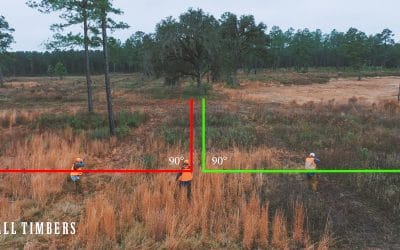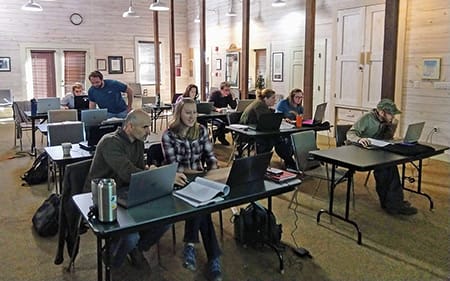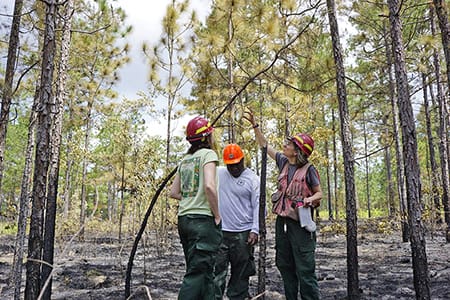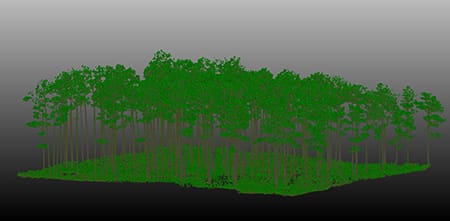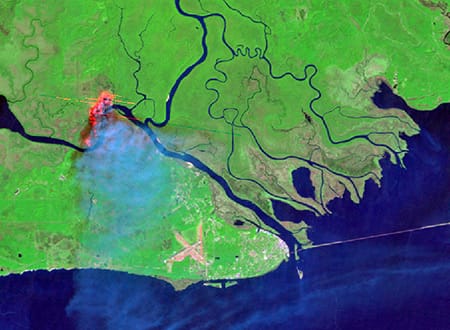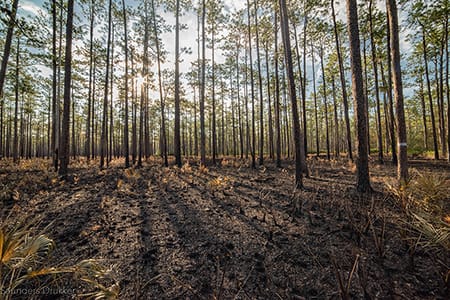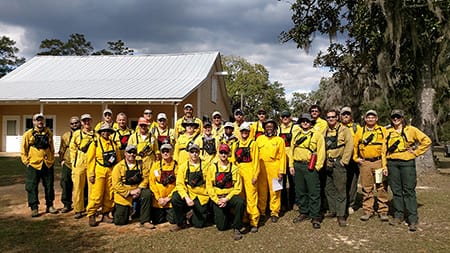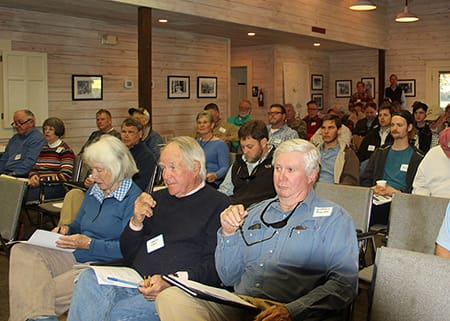Wild turkeys, like a host of other ground-nesting birds in the Southeast, need regular prescribed fire to maintain their habitat.
As many land managers start to head into the woods to light off fires that will inevitably help turkeys, bobwhite, and a number of other birds, there is a lingering question about whether prescribed fire poses a risk to turkey and their nests.
Like a lot of things in habitat management, the answer is, “It depends.”
Because there has been a decline in turkey populations in many areas across the Southeast there is ongoing research to try and understand the reasons.
Managers focused on creating bobwhite habitat are typically burning at times that do not intersect with the time quail start laying clutches of eggs at the end of April and early May.
But fires in March and April do have the potential to happen at the same time turkeys are laying eggs and beginning to incubate them.
The basic recommendation will always be to put fire on the ground. The benefits of frequent prescribed fire on a two or three-year frequency will do more good than not burning out of fear of possibly burning up a few turkey nests.
Tall Timbers Game Bird Director Dwayne Elmore, however, said there are ways you can apply fire to the landscape that can dial down risk and actually benefit young poults as they hatch and mature through the summer.
There are several factors at play.
First, decide what your management goals are. Are you looking to grow your turkey population exclusively, or are you focused on bobwhite or other animals, or a combination of goals?
Although turkey and bobwhite share similar characteristics – they’re both gallinaceous and benefit from the fire-maintained plant communities – they have some striking differences.
While they can both thrive in pine savannas, turkeys are more generalists and exist and nest in places where bobwhite just aren’t found.
At some point, you have to decide which is a more important goal and manage toward that, Elmore said. That’s not to say you can’t manage for multiple species, but it will result in trade-offs.
“If I’m trying to maximize wild turkey, you can’t say that’s going to be perfect for quail and vice versa,” he said. “Am I all in on turkey or all in on quail? That will inform how you set your fire management plan.”
Fire frequency
Burning at the right frequency is crucial to maintain vegetation that turkey, bobwhite, Bachman’s Sparrow and other ground nesting birds are going to use.
If the constraints of seasonality, fire intensity or patch size are keeping you from burning at the right frequency, those species will suffer..
But turkey and bobwhite differ in their nesting habits.
Bobwhite have a broad nesting window over the course of several months which occurs after most managers are finished burning in late April. Yearly weather patterns, such as drought or heavy rainfall, can also affect when bobwhite nest.
Turkeys, however, are more synchronous with many hens laying nests by the end of March and mid-April in the Southeast. They can re-nest if there is a loss of a clutch, but because the window is so time constrained, they may not and re-nests will have smaller clutch sizes.

Turkeys are opportunistic nesters that will lay clutches in a variety of habitats. Smaller patch size in burn plots can help offset any concerns of destroying nests with growing season fire.
Large scale impacts to cover, say burning in significantly larger blocks, can impact nesting but that is where there is a host of unanswered questions about nesting and fire.
Retired Tall Timbers ornithologist Jim Cox co-authored a paper detailing the interplay between a half-dozen avian species, including turkeys, and lightning season fire.
Cox found that turkey hens avoided areas for nesting that had not been burned in the past two years, meaning that they typically nest in areas not scheduled for burns.
Cox concluded that growing season fires in native groundcover areas that have not been burned for two or more years are not likely to threaten many nests.
However, turkeys will readily nest in two to three year rough in old field habitat
A 2005 paper in which researchers monitored 22 hen turkeys at the Savanna River Site in the sandhill region of South Carolina found that only two nests were destroyed by growing season fire. Managers on the site however burned just 1.2% of the area during the growing season, however a 10% loss in nests is not insignificant.
Similarly, a 2012 master’s thesis at the University of Georgia monitored 52 nests at the Jones Center and on Silver Lake Wildlife Management Area. Of those, just six nests were destroyed by growing season fire.
Of those, four re-nested.
The average burn size in the Jones Center study was 58 acres and the average burn size at Silver Lake WMA was 28 acres.
Although there are a handful of studies, there isn’t enough on which to make specific management recommendations, Elmore said.
“Fire frequency is the trump card,” according to Elmore. “Similar to bobwhite and other ground nesting birds, we need to make sure that we’re burning at the right frequency and at the right scale so vegetation is appropriate for wild turkey year around.” However, that doesn’t mean that seasonality, patch size and intensity don’t matter at all.
Patch size
The burn patch size and layout of burn patches can make a huge difference in the response from ground nesting birds.
The general recommendation in the Southeastern Coastal Plain is to burn 30-50% of a property in a checkerboard pattern that leaves unburnt patches in close proximity to recently burned areas that will resprout with grasses and forbes crucial for brood habitat.
Findings in bobwhite research have shown that smaller burn patches are generally beneficial to quail, partially given their small home range.
Although turkey have larger home ranges and daily movements, they too are likely to benefit from smaller scale burning versus fires that cover hundreds or thousands of acres and leave little remaining vegetative cover.
Data are still being collected that can help make specific recommendations on the appropriate burn scale for wild turkey, making it hard to do anything but make inferences about impacts to turkey nesting.
Elmore laid out a simple equation that suggests that smaller burn blocks can help avoid issues.
Let’s say a manager has a 1,000-acre property. Of that, 800 acres is burnable and you want to burn half to maintain a mosaic pattern. Because of logistics, only 200 acres are scheduled to be burned during the time when most turkeys are nesting.

Smaller burn block sizes that are well spaced with adjacent unburnt patches are beneficial to ground nesting birds like turkeys and quail.
Therefore, you only have 1/5 of the property where a turkey may be nesting in an area being burned that year.
If there is an even distribution of hens and they happen to be nesting all at the same time, which is unlikely, there is a pretty slight chance of fire affecting a handful of nests if at all. So, it’s possible to lose a few nests to fire but there is also a likelihood that only one of those even hatched.
But, if the entire 800 acres is burned at once during turkey nesting, there is much more of a likelihood of nests being impacted, making the scale of fire an important factor.
“The recommendation is burn units of about 40 to 50 acres, although not every property or manager is going to be able to do that,” Elmore said. “Even if they can’t be that small, managers should burn as small as practical. Burning thousands of acres at a time, is not conducive to bobwhite or wild turkey.”
Seasonality
If turkeys are your objective, then applying fire strategically before hens begin to lay can help avoid most nest disturbance.
Burning in late winter or early spring, say December through mid-March, can still be beneficial to turkey and can be applied to areas where they are more likely to be found than bobwhite, for example along hardwood ecotones or wetlands.
A point of concern that leads managers to burn for quail a little later is the declining prevalence of raptors as they migrate north in the spring.
It’s really about applying fire at the right time in the right place to drive habitat composition. Fire can be thoughtful and applied in a way that can minimize risks to turkey and quail nesting by spreading out burn windows.
If areas of the property are more appealing to bobwhite, then applying fire during March, April or May based on those other goals can help achieve habitat for both species on the same property.
“You can be strategic on your property and spread your burns out,” Elmore said. “There’s nothing that says you should only burn during one month. It depends on many factors including what your habitat objectives are –reducing hardwoods or increasing legumes – for instance. You have to factor in all the species that you’re trying to manage for on that property.”
In summary, the need to get fire on the ground to create habitat for young turkeys and for adults far outweighs potential impacts to nests.
“You’ve got to have the habitat You’ve got to have the fire frequency Do not let seasonality concerns keep you from burning at the appropriate frequency and scale.” Elmore continued. “If that’s happening, you’ve ignored the more important factors.”
Want to learn more?
The following podcasts by the Southern Fire Exchange and Wild Turkey Science dive into the topic of fire and turkey nesting and are great resources.
Southern Fire Exchange
Part 1: https://open.spotify.com/episode/1moN7OieAlI6mY0PIlwGpX?si=3633b811e0294d3b
Part 2 https://open.spotify.com/episode/47HGS6fBTZI8e0NIFuUP2L?si=a9f47e0623f54819
Wild Turkey Science
https://open.spotify.com/episode/68fZhw8UU6219fdTCHuUrv?si=c0240698f3df4e5a





